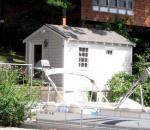20th Century Stow
Railroads played a role in one significant part of Stow – Lake Boon. In the 19th Century, a dam was constructed across the stream connecting Boon Pond to the Assabet River in order to enlarge the Boon Pond basin and maintain a reserve supply of water to ensure consistent power for the mills in Maynard during low-river periods. The pond expanded into a lake three times it original size.
Still, the basin’s shoreline fluctuated as water was drained periodically. Development was impractical. By 1900, the mills had been converted to diesel-powered electricity and the shoreline fluctuations ceased. And the lake had a railroad line from Boston running right past it.
It quickly became a summer getaway spot for Bostonians. First they stayed over in tents, then in small cottages, then in more elaborate homes. Cottages and social clubs like “The Twilight Club” – usually composed of young men – lined the shore. Boats, including a 50-seat launch called The Princess plied the lake, carrying commuting Bostonians from their docks to the Lake Boon Station for the train ride to work in the city each morning and home in the evening. The lake community had its own store, hotel and church.
An anomaly was that, in an era of bad roads, Lake Boon was more accessible to Bostonians by train than to Stow residents by horse or automobile. By World War II, this had changed and Lake Boon’s life as a resort had declined. Today, the lake is lined by some 450 year-round homes and is an integral part of the Stow community.
Stow did gain residents from one important source – immigration. Many immigrants were workers who came to labor in the mills in Gleasondale and Maynard and, as soon as possible, acquired land and became farmers. Notable among them was a wave of Danish immigrants around the turn of the century – so many that they established a Danish Brotherhood, with a hall on Hastings Street. In the early 1900s, it was Finland’s turn – a wave of Finnish immigrants. For a time, Finnish was the dominant language spoken along Taylor Road. Most importantly, Stow’s new citizens settled in and made significant contributions to Stow life and development.
As the 1900s began, some Stow farmers took a different approach to dealing with untenable competition – specializing in apple orchards (pears and other fruits were also in the mix but the central concern of Stow’s orchards was apples). In the first half of the century there were more than a dozen working orchards in the town. The largest, Fruit Acres, had some 4,000 trees planted.
As the 20th Century progressed, however, the inability to compete with western farmers repeated itself with orchards. As suburbanization progressed, some sold their land for development – Fruit Acres is now the Birch Hill residential area. Others adopted new strategies. Today, five working orchards remain in operation – all emphasizing the “pick-your-own” approach, with attractions such as hayrides and petting zoos. Most Stow-grown apples are sold through each orchard’s farmstand.
For some farmers, poultry-breeding became another strategy for specialization. Over the first half of the century, the town boasted at least a dozen poultry farms. In 1950, the town report counted 30,430 chickens and ducks within Stow. For a while significant dairy operations were based in Stow.
But overall, farming declined. By 1933, the number of farms was down to 22. By 1974, only two dairy farms remained. By 1983, dairy farms were completely gone. And commercial poultry farming disappeared.
Photos
 Lake Boon Boats- During the first half of the 20th Century, Lake Boon had a life as a resort area for people from Boston and other areas.
Lake Boon Boats- During the first half of the 20th Century, Lake Boon had a life as a resort area for people from Boston and other areas.
Finnish Sauna- The small chimney identifies this shed on the shore of Lake Boon as a one-time Finnish sauna, a legacy of the waves of Danish and Finnish immigrants who settled in Stow in the early 20th Century.
 Assabet Lodge - Established on While Pond Road in the early 20th Century, Assabet Lodge was a resort featuring tiny cabins, boating and fishing, and a nine-hole golf course. By the 1950s, most of the resort had disappeared - but the nine-hole course remains as Stowaway Golf Course.
Assabet Lodge - Established on While Pond Road in the early 20th Century, Assabet Lodge was a resort featuring tiny cabins, boating and fishing, and a nine-hole golf course. By the 1950s, most of the resort had disappeared - but the nine-hole course remains as Stowaway Golf Course.
